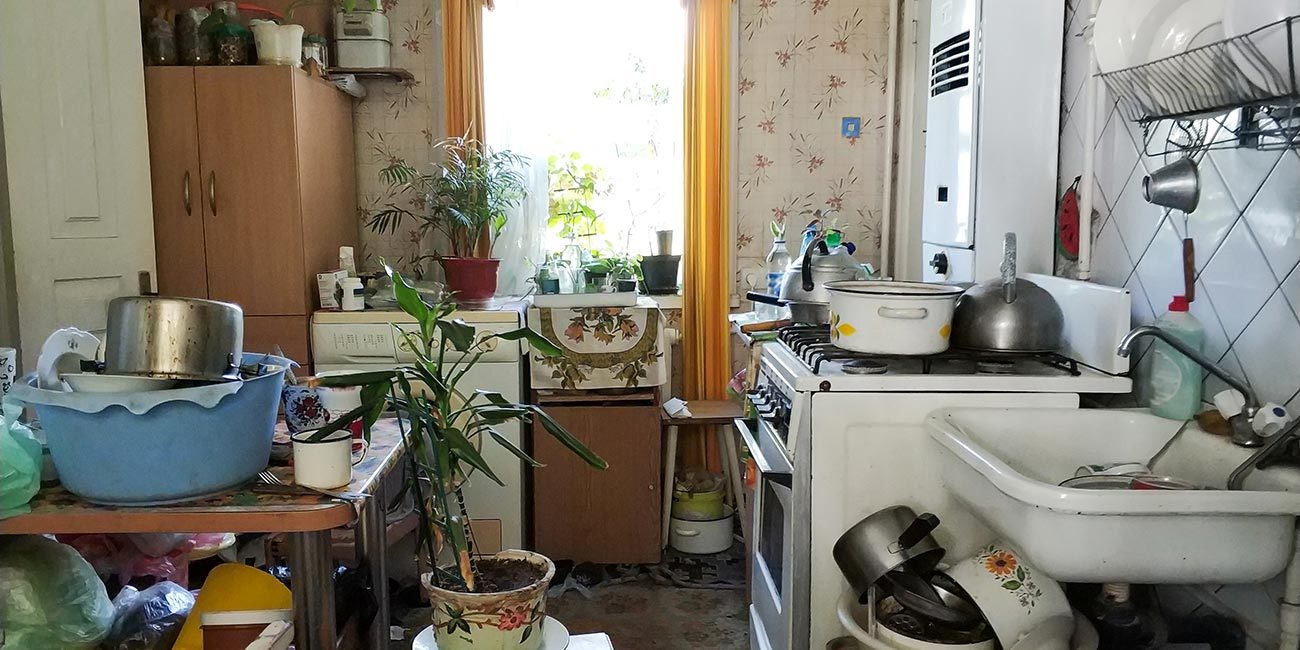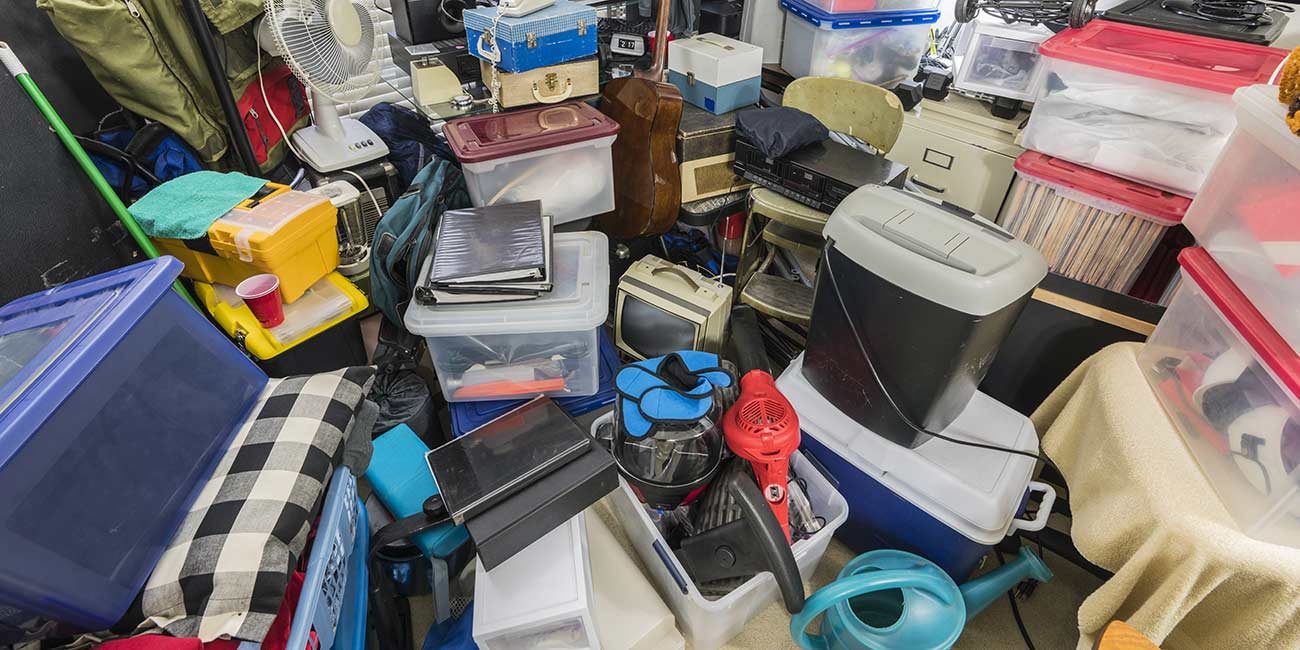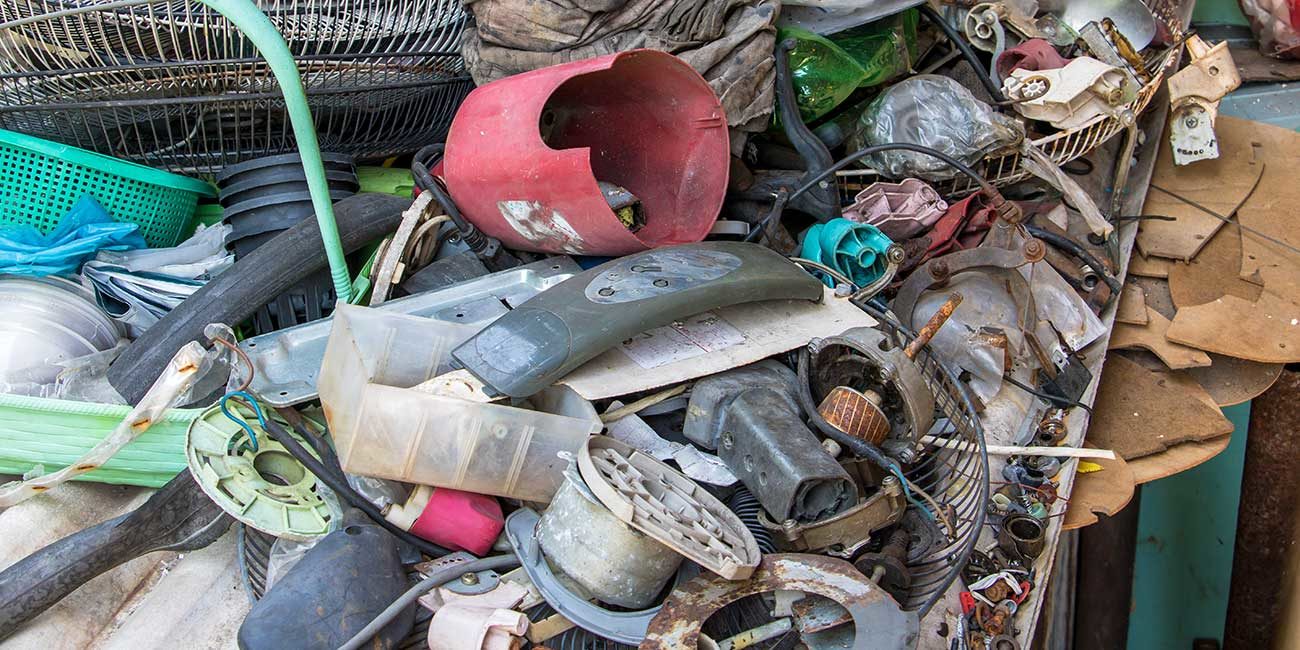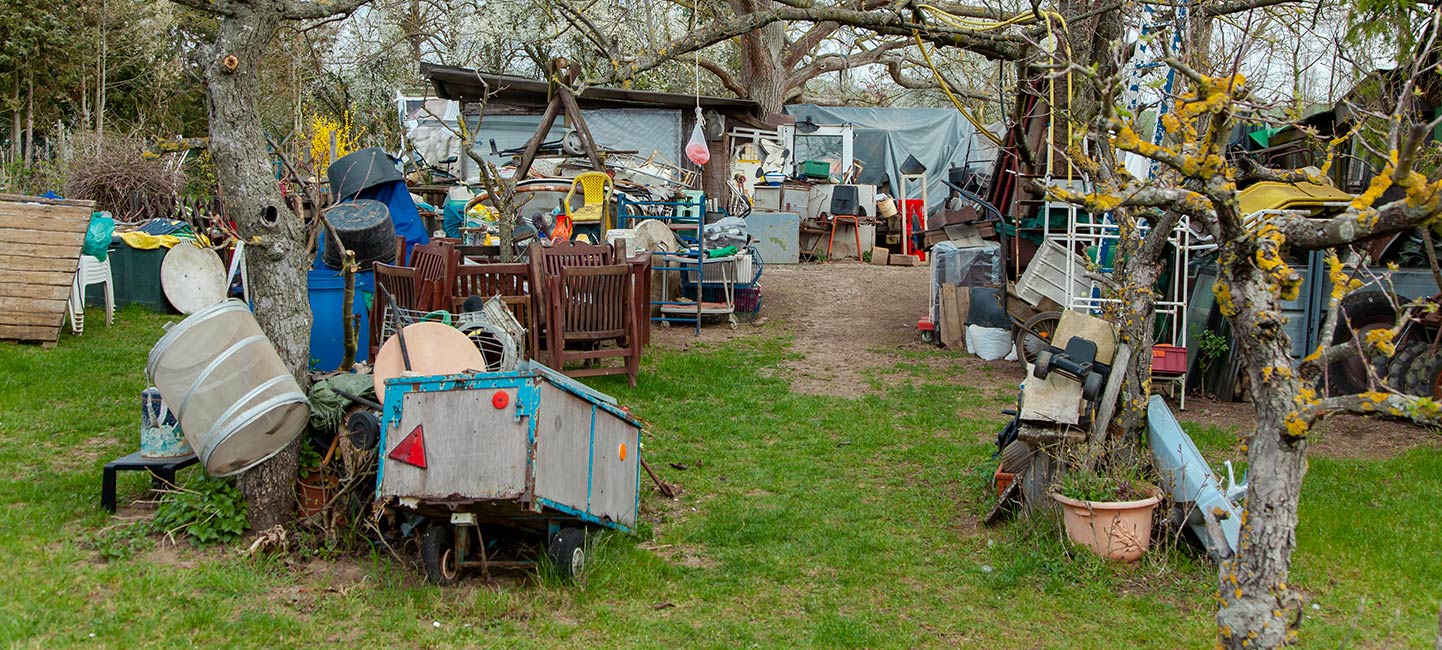Hoarding, which affects between 2% and 5% of the population, can be dangerous to anyone, especially when it becomes out of control. However, this problem can be riskier for certain groups. In reality, the dangers of hoarding are more likely to pose a serious threat to the health and safety of older adults.
Many family caregivers do not anticipate having to deal with an elderly person’s hoarding. Common elder goals like being independent and aging in place are hampered by the extreme clutter and dangerous and unhygienic conditions brought by hoarding. Understanding why hoarders hoard and finding effective ways to handle this behavior will help you reduce the risks in your loved one’s home.


What Is Hoarding Disorder?
Hoarding disorder is a recognized mental disorder describing people who collect too many things that others may consider worthless. They have a hard time getting rid of their belongings, and parting with them causes them extreme distress. This results in clutter, which makes it difficult for them to use their living or working areas. Newspapers, clothing, and books are the most commonly hoarded items. Hoarding affects people of all ages, genders, races, economic, and educational backgrounds.
Some people believe that hoarding is a reactionary psychological issue caused by feelings of scarcity. However, researchers are still unable to determine its exact cause. Brain function, genetics, and stressful or traumatic life events are all being looked into as potential causes.
People with hoarding disorder are also likely to experience other mental health conditions such as anxiety, depression, obsessive-compulsive disorder (OCD), and attention deficit hyperactivity disorder (ADHD). Hoarding and dementia are also closely linked with each other. Hoarding is also a symptom of Diogenes syndrome, which is a more serious disorder characterized by self-neglect, squalor, apathy, hoarding and lack of shame. What causes hoarding is still a mystery to experts, but several factors were identified that might make a person prone to hoarding. These factors include:
- Family history. When a family member has a hoarding disorder, the problem is more likely to be passed to other members of the family.
- Indecisiveness is a common personality trait among hoarders.
- Stressful life events. Some people develop hoarding disorder as a destructive coping mechanism to a stressful life event such as divorce, death, or the loss of possessions in a fire.
- Social Isolation. People who hoard tend to be socially isolated. Whether it is a result or cause of hoarding is still being debated by experts.
- Alcoholism. According to studies, roughly half of all hoarders have a history of alcohol abuse.


Signs And Symptoms of Hoarding
Cluttering and collecting are not the same things as hoarding. So how can you tell if a person is becoming a hoarder? Hoarders collect and store various items from their daily life in an unorganized manner. Hoarders find it very difficult to discard, sell, give away, or even recycle those items. Having a hoarding disorder will surely obstruct a person’s life.
The following are some symptoms and behaviors of a hoarder:
- Constant difficulty in letting go of possessions regardless of their worth.
- Acquiring excessive items that are not useful nor needed or for which there’s no space.
- Compulsive shopping and having a high emotional attachment to things.
- Piling up clutter to the point of making spaces unusable.
- Keeping too many pets or animals which, they can no longer properly take care of.
- Having difficulties in planning and organizing, procrastinating, and being indecisive and avoidant.
Excessive acquisition of objects and refusal to dispose of them leads to:
- Objects that fill and clutter their living areas and walking spaces, making the space unusable for its original purpose, such as filling their couches and leaving them no space to sit, or filling their kitchen to the point where it becomes impossible to cook.
- Untidy stacks or piles of items, such as newspapers, documents, books, clothes, or other “sentimental” things.
- Excessive, unhygienic, or unsanitary accumulation of food or trash.
- Severe discomfort or problems with functioning or keeping their selves and others safe at home.
- Having troubles in organizing things leading to frequent misplacement of important items.
- Conflicts with family members who are trying to declutter their home.
Individuals who have hoarding disorder usually keep too many items because:
- They believe that the items are not worthless and can be used at some point in the future.
- Being surrounded by the things they collected makes them feel more secure.
- They do not want anything to go to waste.
- The things hold significant emotional value to them, as they serve as a reminder of happier times or as a remembrance of a beloved person.


Why Is Hoarding More Common in Older Adults?
Many people’s social engagements, both in terms of quality and frequency, drop significantly as they get older. Because of this, older adults often feel lonely and isolated from the rest of the world. As a result, they may begin to engage in actions that appear to help them in coping with loneliness and sadness. These activities can sometimes focus on the accumulation of objects, which can range from clothes and souvenirs to food and even real, breathing animals.
According to a study undertaken by researchers at the University of California, San Francisco (UCSF), 13% of older adults experiencing late-life depression report severe compulsive hoarding.
However, most experts agree that hoarding is not a problem that starts when a person is older. Most people can trace their hoarding habits all the way back to their childhood or adolescence. While some experts say it’s unclear whether hoarding tendencies worsen with age or whether a person’s ability to manage the problem worsens, there’s no denying that older people are more likely to hoard therefore the disorder has a greater impact on them.
The Dangers of Hoarding in Older Adults
While hoarding poses safety hazards to anyone, older people are especially vulnerable. Understanding the safety concerns associated with hoarding is an important step in seeking help. The following are some of the serious problems older adults experience because of hoarding
• Health Issues and Diseases Caused by Hoarding
Excessive clutter can obstruct airflow and vents, resulting in low oxygen levels. On hot days, this will make it difficult to cool a home which can also increase carbon dioxide levels.
Hoarding can also create conditions that promote the spread of bacteria and viruses that cause sickness. Pests and food-borne illnesses can be spread through spoiled food. Some pests can carry dangerous diseases and viruses can be spread through bites. Bacteria can also be carried and transmitted throughout the house by other bugs or rats.
Mold can also grow in areas of the house that are difficult to see or reach. Mold spores can be harmful to people who have allergies. Mold can also cause respiratory problems even if a person is not allergic to it.


• Greater Risk of Failing
Hoarding can make it difficult to avoid falling. Due to the great quantity of clutter, it may be difficult for a person to move around. An older adult is more likely to trip over something in the walkway or fall while attempting to climb over a pile of clutter.
An older adult may become easily trapped if a pile of clutter falls on top of them. This circumstance may result in physical injury. It could also take a long time to find the person who is trapped.
One in every four older individuals is admitted to the hospital each year because of a fall injury so it is important to make sure your loved ones’ homes are not susceptible to this kind of accident.
• Increased Fire Hazards
Hoarding can make a person’s home more vulnerable to fires or expedite the spread of a fire. Fire hazards can go undiscovered if the house isn’t maintained on a regular basis. Stacks of newspapers, magazines, or other materials can readily catch fire, quickly spreading throughout a home.


• Delays in Emergencies
Hoarding might make it difficult for emergency responders to do their jobs. Emergency personnel has been known to suffer injuries when attempting to aid people who have stored an excessive amount of possessions in their homes.
Hoarding can also make it difficult for emergency personnel to reach someone who requires immediate assistance. The time lost due to the delayed response may shaved off valuable time that can greatly impact an injured person’s recovery.
• Decreased Mental Health
According to studies, 75% of persons who hoard items also suffer from other mental health issue, such as anxiety, depression, or social isolation. Hoarders often refuse to let visitors or family members into their homes, resulting in isolation. Hoarding can also lead to feelings of rage, hatred, and sadness in both the hoarder and their family members.
5 Things You Can Do to Help an Older Adult Who Hoards
• Establish Trust and Confidence
You may believe that you have already established the trust and confidence of your loved one. However, when one’s hoarded items is on the line, this confidence does not necessarily remain to family and close friends. This is particularly true if you have previously “helped” this person by disposing their belongings without obtaining their permission or considering their objections.
Be patient and take it slowly. Declare and then follow through on your promise to respect your loved one’s decisions regarding the cleaning process of their hoarded items. Talk to a hoarder with empathy and sincerity.
Underhanded methods may help you get rid of some of their hoarded things, but they are more likely to harm your relationship and sabotage whatever long-term progress you’ve achieved.
• Set Realistic and Achievable Goals
A hoarder’s collection frequently takes up a large portion of their home and may even overflow outside in their yards or garages. Assisting a severe hoarder in decluttering and organizing their things is a truly massive undertaking and attempting to complete the entire project immediately will be overwhelming. Some people even reported that it took them years to fully sort out all of the hoarded materials of their loved ones.
Be sure to set reasonable goals that take into account your loved one’s ability to work through their hoarded items at their own pace. Breaking the project down into small, manageable goals will prevent a hoarder from feeling rushed or under pressure and will ideally offer them a sense of achievement when they are done.


• Celebrate Small Achievments
Even a little achievement, such as recycling a pile of old newspapers, should be celebrated! When a hoarder achieves a comfortable objective, they are more likely to realize that the process of letting go of things is not as painful as what they had in mind.
Positive encouragement will boost your loved one’s self-esteem and inspire them to keep improving their decision-making and organizational skills. Even though it will be a lengthy process, it is very possible to help older adult hoarders in reclaiming their house and making it again a secure and healthy place to live in.
• Find Your Own Support
Helping an older adult hoarder is a huge challenge, and you will need support for your own. To cope with the challenges of dealing with this mess, you can seek help from a friend, a therapist, or an online support group.
Even if you know you are acting in your loved one’s best interests, a hoarder will typically label you as their enemy. The idea of parting with or disposing of a hoarder’s collection can make them very uneasy, and you could become the subject of their rage. Because of this, it is essential that you have a safe space where you can vent and talk about the painful feelings that can develop during this process.


• Seek Professional Hoarding Disorder Treatment
Hoarding disorder is a clinically diagnosable mental disorder that requires treatment to help people overcome their hoarding habits. A severe hoarding disorder is something you can’t solve on your own. You will need a professional help in addressing this problem.
Therapy is usually utilized to help people in processing the reasons for their emotional attachment to objects. Hoarding can be mitigated with a type of therapy known as cognitive-behavioral therapy. Certain medications may be helpful as well.
To look for a therapist for your loved one, you can begin by searching for “hoarding disorder therapist near me” on Google. This will take you to many therapist directories you can choose from. You can also find the contact information of these directories in their websites.
Before choosing a therapist to work with, you should do some research to make sure he/she is a good fit for the role. Make sure to find someone competent and someone you and your loved one can trust and feel at ease with.
You can also seek advice from your friends or relatives who have gone through a similar problem. They may have useful suggestions and good personal recommendations. Nonetheless, you still need to interview the therapist to determine if they are a suitable match for your loved one.
Get Treatment for Your Loved One’s Hoarding Before It Gets Worse
As previously mentioned, hoarding gets worse with age. Hoarding disorder could have far-reaching, negative effects on practically every part your loved one’s life if it is continuously left untreated.
While a hoarding disorder can be quite difficult to treat, recovery statistics are promising for people who received evidence-based hoarding treatment. The most effective treatment is cognitive behavioral therapy, which has demonstrated to positive results in 70% of patients.
Do not wait for the risks to materialize before taking actions. If you are living with a hoarder, your health is at risk too so act now before it’s too late!



Leave a Reply